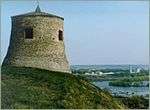Chuvash dragon
Verechelen (Chuvash: Вĕреçĕлен or Вӗриҫӗлен, Вӗриҫлен, Вриҫлен, Russian: Вереселень) also known as Chuvash dragons differ from their Turkic counterparts (such as Zilant), as they are supposed to reflect the pre-Islamic mythology of Volga Bulgaria. The word means invisible snake.
Varieties
Chuvash dragon is Věri Şělen (Вěри Çěлен, lit. "fire snake"). Like the Russian Gorynych, the creature has multiple heads and leaves a fiery wake at flight.
Arşuri (Russian: Арçури, Арзюри; Turkish: Arçura) a wood demon, often turns into a snake, but more often he looks like Şüräle. The Iranian dragon, Ajdaha (Аçтаха), is also mentioned from time to time, probably due to Iranian influence to Volga Bulgaria.
Legends
According to one legend, when the Bulgars came to found the town of Bilär, they discovered a big snake living in the area. When they decided to kill it, the snake begged for peace and asked Allah to give her wings. Once she got wings, the snake flew away from Bilär.
Another great snake, or dragon, was said to live in a pagan tower temple at Alabuğa. Although the Bulgars adopted Islam as early as the tenth century, the snake allegedly survived until the time of Tamerlane's invasion.
Ibn Fadlan, who visited Volga Bulgaria in the 10th century, referred to numerous snakes, especially on trees. Once he saw a big fallen tree, which was longer than a hundred ells. Ibn Fadlan wrote that he'd seen a big snake at the trunk that had been almost as large as the tree itself. The Bulgars allayed his fears, assuring him that the snake was not dangerous.
Bibliography
- Чăваш халăх пултарулăхĕ: Мифсем, легендăсем, халапсем. — Шупашкар: Чăваш кĕнеке изд-ви, 2004. (Russian)
